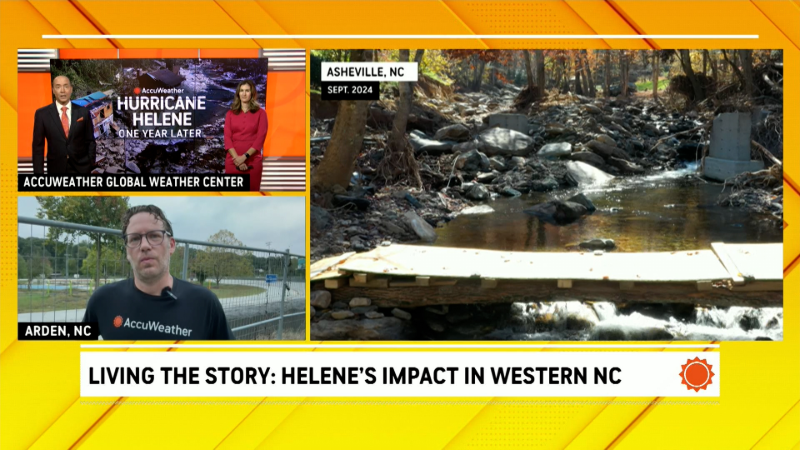Tropical Storm Imelda forms; To bring flooding, damaging surf to southeast US Coast
Newly formed Tropical Storm Imelda to strengthen and bring flooding rain, storm surge, and gusty winds to parts of the Southeast U.S. coast this week. AccuWeather has the latest impacts and track information.
Chief Meteorologist Jon Porter demonstrates how the free AccuWeather app can help you keep track of the storm including any future hurricanes throughout the season. Porter uses former Hurricane Erin as an example.
Heavy rain and storm surge will lead to flooding along a portion of the southern Atlantic coast of the United States for a time this week as Tropical Storm Imelda, will bring drenching downpours and gusty thunderstorms to parts of the southeastern U.S. coast, AccuWeather meteorologists warn. Imelda is forecast to become the next Atlantic hurricane.
An eastward shift in the forecast track of Tropical Storm Imelda is due in part to powerful Hurricane Humberto to the east, tugging on the storm, and a southward push of dry air from high pressure building over the Northeast states.

The dashed red line represents AccuWeather meteorologists’ forecast path for the eye of Imelda. The gray shaded areas on either side of the forecast path represent alternative paths the storm could take based on changing steering conditions. Tropical storm and hurricane conditions will extend well beyond the track of the eye.
As warned by AccuWeather meteorologists early last week, the tropical setup in the western Atlantic is highly complex, with Major Hurricane Humberto and the budding tropical storm within several hundred miles of each other. There hasn't been a setup similar to this since Hurricanes Matthew and Nicole in 2016. However, those two hurricanes were farther apart than the unfolding situation this week.
Have the app? Unlock AccuWeather Alerts™ with Premium+
One key difference between fall 2016 and this season is that Matthew was much stronger than what is anticipated for Imelda. Matthew hugged the Carolina coast back then, while the less intense Imelda this week will be pulled on by the much stronger Humberto near Bermuda and hence the core of Imelda is forecast to take an offshore track.

Imelda, along with another non-tropical disturbance, is expected to result in heavy rain in Atlantic coastal areas from Florida to North Carolina and southern Virginia. The effect will be a plume of tropical moisture that extends from the Caribbean to the Gulf Stream and adjacent land areas in the southeastern U.S.
"A localized area of 8-12 inches of rain is forecast to occur over the Bahamas with a zone where 2-4 inches of rain will fall along the South and North Carolina coasts," AccuWeather Senior Meteorologist Reneé Duff said.
Lighter rain will fall farther inland over the Carolinas and in southeastern Georgia. With lower amounts forecast when compared to a few days ago, the risk of river flooding in the Midlands has diminished.

"Where a more gentle rain falls, it can help to ease drought concerns," AccuWeather Senior Meteorologist Chad Merrill said.
The greatest risk of flooding from heavy rain and a storm surge will be along the immediate coasts of the Carolinas and perhaps Georgia. With the combination of heavy rain and above-normal tides produced by the storm, localized flooding of roads is possible in parts of South Carolina and North Carolina, including Charleston, Myrtle Beach, Wilmington and Cape Hatteras. A storm surge of 1-3 feet is forecast from the northern Bahamas to southeastern Virginia this week.

The AccuWeather RealImpact™ Scale for Hurricanes along the southeastern coast of the United States is one.

The difference in pressure between Imelda offshore and the high over the Northeast will kick up significant wind gusts along the southern Atlantic coast to tropical-storm force winds(40-60 mph).
These wind gusts may cause localized tree damage and scattered power outages.

The main role of the wind will be to agitate the sea. Nearby, the strengthening Imelda will contribute, but perhaps just as much or more will be the much stronger Major Hurricane Humberto, which recently peaked as a 160-mph Category 5 a few hundred miles to the south of Bermuda. Humberto is forecast to track west of Bermuda, perhaps not too far different from former Category 5 Hurricane Erin this past summer.
The effect of wind pushing on the surface of the sea will lead to massive swells offshore between Bermuda and the U.S. for many days. Cross-Atlantic shipping, fishing and cruise interests are urged to monitor the path of the two tropical systems and the wave effects produced by both.

As these swells reach the Atlantic beaches of the U.S., large breakers with strong rip currents are likely. The wave action and storm surge will have an erosive effect on the beaches, with considerable damage possible for much of the upcoming week.
Looking ahead, the zone from near the Bahamas to the western Caribbean and the southwest Gulf may continue to be a spot for tropical development in the weeks ahead. Moisture and abundantly warm water will be plentiful, so when upper-level winds relax and conditions become favorable for atmospheric pressure to drop, one or more tropical features may evolve. The proximity to populated areas in the region would limit advanced warning should development take place.

As Imelda tracks to the east later this week, it may pass very close to Bermuda a hurricane with a second round of rain, wind and rough seas. Depending on the track and intensity, impacts in Bermuda could be worse from Imelda than from Humberto.

Want next-level safety, ad-free? Unlock advanced, hyperlocal severe weather alerts when you subscribe to Premium+ on the AccuWeather app. AccuWeather Alerts™ are prompted by our expert meteorologists who monitor and analyze dangerous weather risks 24/7 to keep you and your family safer.
Report a Typo














